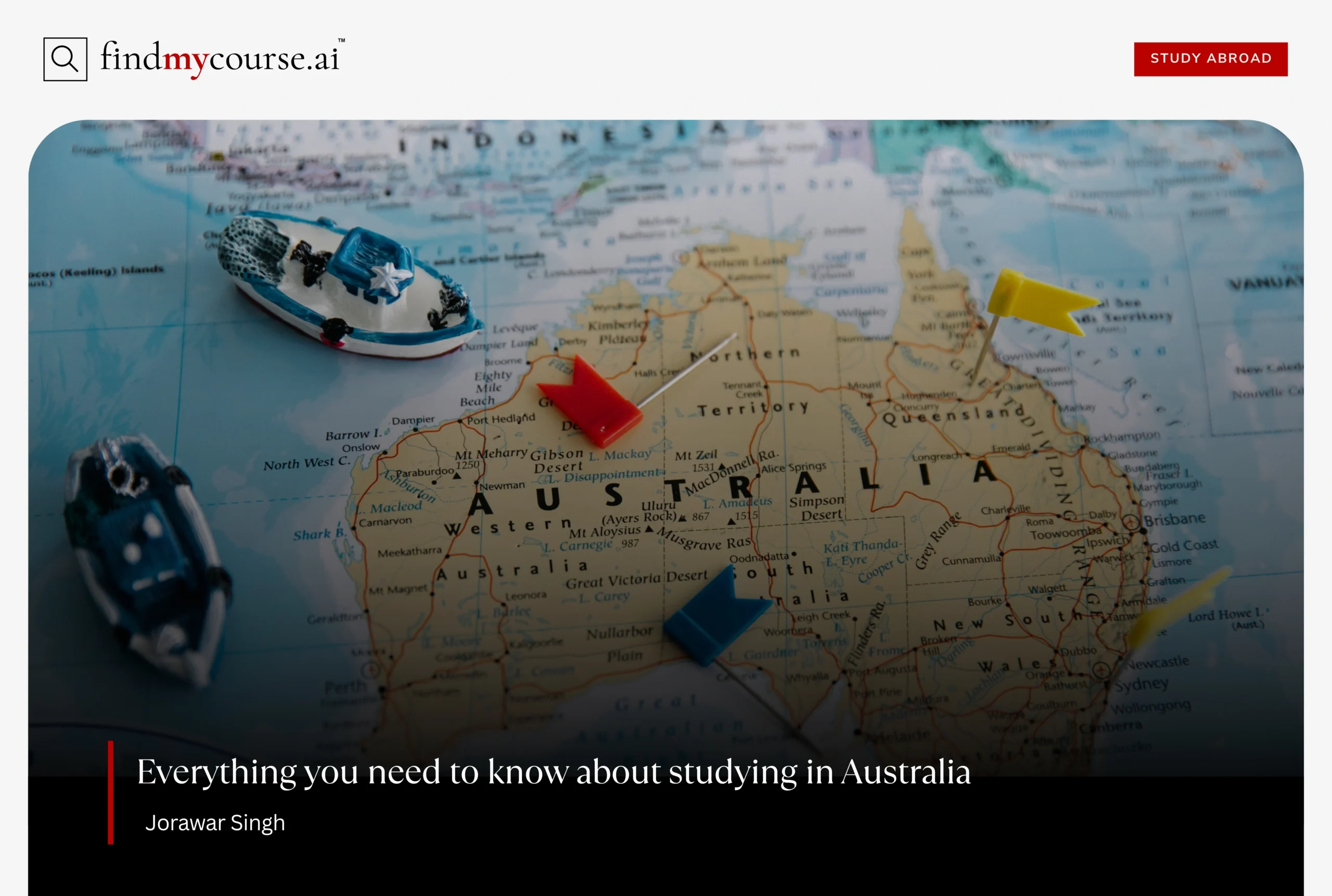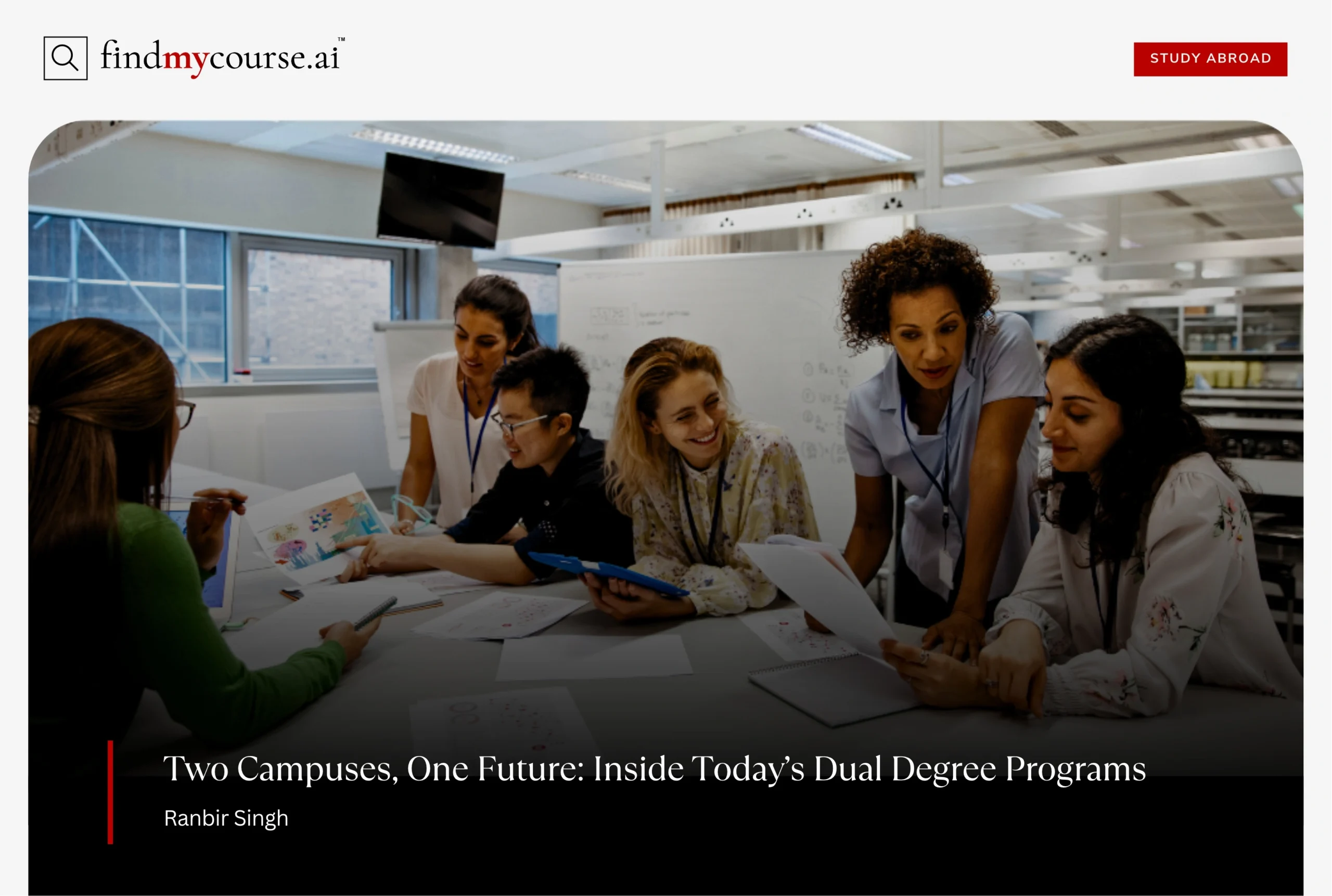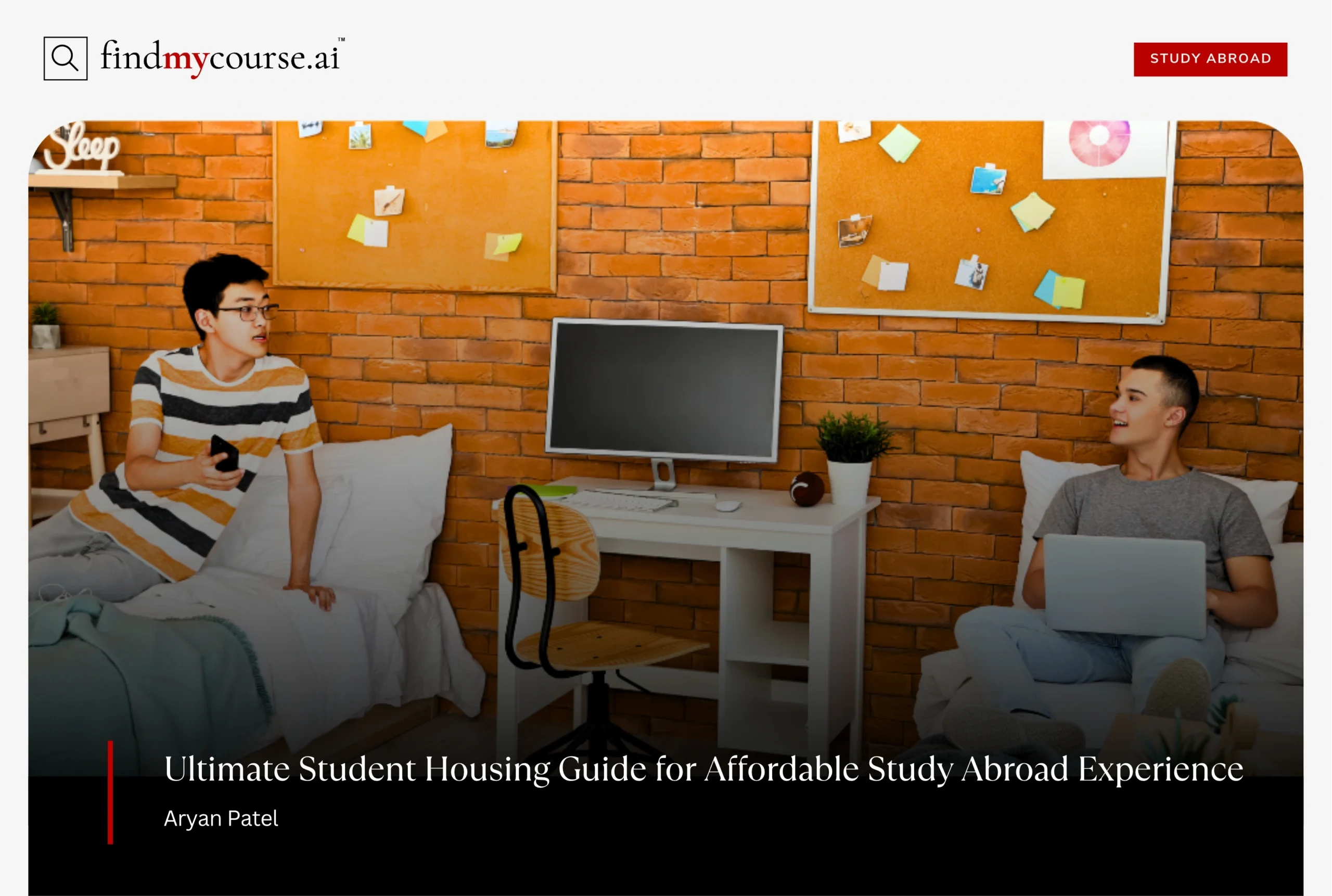Are you dreaming of study in Australia in 2025? Perhaps it’s the world-renowned universities that catch your eye, the sight of kangaroos in regional campuses, or the thought of sipping a perfect flat white beneath the southern sun. Whatever draws you, you’ve found the right starting point.
Australia continues to shine as a favorite destination for international students. With new visa regulations, stricter application procedures, and fresh trends in sought-after courses, navigating your path can feel overwhelming. Fortunately, this guide is here to light the way.
Why Choose to Study in Australia? (Besides the Koalas)
Imagine studying where vibrant cities meet breathtaking beaches, and world-class education opens doors to global careers. Australia, blends academic excellence with a laid-back lifestyle, making it a top choice for international students. In 2024, over 500,000 international students, including 122,391 from India, chose Australia for its top-tier universities, diverse courses, and post-study work opportunities. Moreover, Australia’s multicultural vibe ensures you feel at home, whether you’re sipping coffee in Melbourne or surfing in Sydney.
Additionally, the country’s high quality of life, with cities like Adelaide and Brisbane offering affordable living, adds to its allure. For Indian students, Australia is particularly appealing due to easy PR pathways and globally recognized degrees. With a low unemployment rate of 4%, graduates find strong career prospects in fields like healthcare and technology. Therefore, why Australia? Because it’s where dreams meet reality under a sun-kissed sky.
What’s New in 2025? Visa, Policy, and Application Updates
Key Changes to the Subclass 500 Student Visa
Australia’s student visa landscape evolves in 2025, with stricter rules to ensure genuine applicants. The Subclass 500 visa, essential to study in Australia, now requires a Confirmation of Enrolment (CoE) before applying from within Australia. Additionally, Australia study visa requirements include proving at least AUD 29,710 in funds for living expenses, up from AUD 24,505. The visa fee is AUD 2000 and, Australia study visa processing time ranges from 16 to 49 days, per the Department of Home Affairs. For Indian students, tightened norms target misuse, with some universities pausing applications from states like Gujarat and Punjab.
Domestic Policy Shifts Affecting International Students
In 2025, Australia caps international student visas at 270,000, with 145,000 for public universities. Consequently, competition increases, so early applications become crucial. Studying in Australia for Indian students faces regional restrictions, impacting genuine applicants. The government emphasizes quality education, encouraging students to align with in-demand fields like healthcare and IT for better visa outcomes.
Work Rights for International Students
Good news awaits! Students can work up to 48 hours per fortnight during semesters and unlimited hours during breaks under the Subclass 500 visa. However, work cannot start until your course begins. This flexibility helps Indian students manage costs while gaining practical experience.
Study in Australia: Top Universities in Australia for 2025
Australia boasts 38 universities in the Times Higher Education Rankings 2025, with nine in the QS World University Rankings top 100. These institutions, offer cutting-edge research and vibrant campus life. Here’s a snapshot:
| University | QS Ranking 2025 | Key Strengths |
| University of Melbourne | 13 | Medicine, Arts, Research |
| University of Sydney | 18 | Engineering, Business, Social Sciences |
| Australian National University | 30 | Politics, Environmental Studies |
| University of Queensland | 43 | Biotechnology, Health Sciences |
| Monash University | 57 | Pharmacy, Business, IT |
Additionally, these universities attract global talent with inclusive campuses where 24% of students are international. Melbourne Institute of Technology excels in hands-on engineering and business programs, making it a top pick in Australia.
Study in Australia: In-Demand Courses in 2025
Australia’s courses align with global job markets, ensuring high employability. In 2025, fields like healthcare, technology, and engineering dominate. Here’s a look at top courses:
| Course | Demand Drivers | Career Prospects |
| Medicine/Nursing | Aging population, global health needs | Doctors, Nurses, Administrators |
| Information Technology | Digital transformation, AI growth | Software Developers, Cybersecurity |
| Engineering | Infrastructure projects, innovation | Civil, Mechanical, Software Engineers |
| Business Administration | Global trade, startups | Managers, Analysts |
| Environmental Science | Sustainability focus | Researchers, Policy Advisors |
These courses, offered by top universities, ensure graduates meet industry demands. Moreover, Flinders University’s affordable IT master’s program costs INR 20 lakhs for the first year, ideal for budget-conscious students aiming to study in Australia.
Scholarships for International Students to Study in Australia
Scholarships ease the financial burden for international students. For instance, Australia offers over 120,000 scholarships, with many tailored for Indian students. Here’s a breakdown:
| Scholarship | Coverage | Eligibility |
| Australia Awards | Full tuition, airfare, living costs | High-achieving Indian students |
| Destination Australia | Up to AUD 15,000/year | Regional university enrollment |
| APEC Women in Research | Research funding | Women from APEC economies |
| University-specific awards | Varies (AUD 5,000–20,000) | Merit-based, course-specific |
To apply, check university websites or the Department of Home Affairs for deadlines. Thus, scholarships make study affordable, especially for Indian students targeting STEM or healthcare programs.
Cost of Living in Australia: Budget Breakdown
Living costs in Australia vary by city, but expect around AUD 1,723 (INR 92,000) monthly, excluding rent. Here’s a breakdown for 2025:
| Expense | Monthly Cost (AUD) | Notes |
| Rent (shared) | 800–1,200 | Cheaper in Adelaide, Brisbane |
| Groceries | 300–500 | Depends on lifestyle |
| Transport | 100–200 | Public transport, student discounts |
| Utilities | 100–150 | Internet, electricity |
| Miscellaneous | 200–300 | Entertainment, dining |
Overseas Student Health Cover (OSHC) costs AUD 500 annually for singles. Thus, for Indian students, studying in Australia is more affordable in regional cities, with lower rent and living expenses compared to Sydney or Melbourne.
Study in Australia : Step-by-Step Application Guide
Step 1: Research and Shortlist Courses & Universities
Start by exploring CRICOS-registered universities and programs. These are essential for obtaining a valid student visa Australia. Consider your academic background, interests, and job prospects. Prioritize institutions that offer strong support for international students, and look into regional universities for additional scholarships and lower living costs.
Step 2: Prepare and Apply to Universities
Once you’ve shortlisted your choices, visit each university’s official website and complete their online application. You’ll need to submit:
- Academic transcripts
- IELTS/TOEFL/PTE score (IELTS 6.0+ generally required)
- Statement of Purpose (SOP)
- Letters of Recommendation (LoRs)
- Resume/CV (if applicable)
Some universities may require application fees.
Note: Apply at least 6–10 months before your intended intake (Feb or July).
Step 3: Receive and Accept Your Offer Letter
If selected, the university will send you either a Conditional or Unconditional Offer Letter.
- A conditional offer may require you to submit additional documents.
- Once you fulfill all conditions, pay the initial tuition deposit (varies by course and institution).
Only after fee payment will you receive the Confirmation of Enrolment (CoE).
Step 4: Obtain Confirmation of Enrolment (CoE)
The CoE is a formal document issued by your university confirming your admission. This is mandatory for your visa application.
Ensure all personal details, course information, and duration on the CoE are correct.
Step 5: Apply for the Student Visa (Subclass 500)
Next, apply for the Subclass 500 student visa Australia through ImmiAccount, the official online portal.
You’ll need to upload the following:
- CoE (Confirmation of Enrolment)
- Genuine Student Statement (replacing GTE in 2025)
- Financial documents showing at least AUD 29,710 in living expenses
- Valid passport
- OSHC (Overseas Student Health Cover) confirmation
- Academic and English proficiency documents
Reminder: Australia study visa processing time varies between 16 and 49 days, so apply early.
Step 6: Complete Biometrics and Medical Checks
After submitting your visa application, you’ll receive instructions to:
- Schedule biometric verification
- Undergo a health check with a panel physician approved by the Australian Government
These steps are crucial for processing your visa without delays.
Step 7: Await Your Visa Decision
You can track your visa status via ImmiAccount. If additional information is needed, you’ll be contacted by immigration authorities.
Therefore, be patient—Australia study visa processing time depends on application volume, background checks, and document accuracy.
Visa delays are common if documents are incomplete or improperly uploaded.
Step 8: Plan Your Move to Australia
Once your visa is approved, it’s time to get ready:
- Book flights to arrive at least 2–3 weeks before orientation
- Arrange on-campus or private accommodation
- Pack documents, medication, and weather-appropriate clothing
- Familiarize yourself with student life in Australia, transport systems, and local emergency contacts
Consider joining Indian student forums or alumni groups to connect before departure.
The Genuine Student Requirement
The Genuine Student (GS) requirement, replacing the Genuine Temporary Entrant (GTE), ensures applicants intend to study in Australia primarily for education. Moreover, you must submit a 300-word statement addressing:
- Your ties to home (family, community, employment).
- Why you chose your course and Australia.
- How the course benefits your career.
- Your study history and visa status.
This statement, submitted via ImmiAccount, assesses your genuine intent to study and use education meaningfully. For Indian students, for instance, emphasizing academic goals and career alignment strengthens your application.
Regional Universities: A Hidden Gem
Regional universities like Charles Darwin University and Federation University offer affordable tuition and a welcoming community. Also, they provide similar academic quality to urban institutions but with lower living costs. Additionally, Destination Australia scholarships incentivize studying in regional areas with up to AUD 15,000 annually. Moreover, these universities have strong industry ties, boosting employability in fields like environmental science and healthcare, making them ideal for students aiming to study in Australia on a budget.
Student Life in Australia
Picture vibrant campuses buzzing with diversity, where 24% of students are international. For instance, Australia’s student life blends academics with adventure—think beach barbecues, cultural festivals, and hiking in national parks. Cities like Sydney offer dynamic nightlife, while regional areas provide a relaxed vibe. Additionally, students enjoy part-time work opportunities (up to 48 hours per fortnight) and access to support services like counseling and career guidance. Thus, studying in Australia means balancing studies with unforgettable experiences, from exploring the Great Barrier Reef to joining student clubs.
Study in Australia in 2025: At a Glance
| Category | Key Info | Requirements | Notes |
| Student Visa | Subclass 500; AUD 2000 | CoE, valid passport, course duration + 3 months | Apply via ImmiAccount; covers full study period |
| Visa Requirements | Legal entry to study | AUD 29,710 funds, IELTS 6.0+, GSR, OSHC | Health checks + biometrics required |
| Visa Processing Time | 16–49 days (avg. 3–6 weeks) | Complete and error-free documents | Apply 4–6 months before intake |
| Top Universities | Melbourne, ANU, Sydney, Monash, Queensland | Strong academics, IELTS 6.0+, CRICOS-registered | 9 unis in QS Top 100; 38 in THE 2025 Rankings |
| In-Demand Courses | IT, Data Science, Medicine, Business, Energy | Relevant background, English proficiency | Align with global job trends; competitive seats in health |
| Scholarships | Awards up to AUD 15,000/year | Merit-based, early application via portals | 120,000+ scholarships, mostly for STEM & health |
| Cost of Living | AUD 1,100–2,170/month incl. rent, food, OSHC | Budget proof for visa (AUD 29,710/year) | Regional cities more affordable than urban hubs |
| Regional vs Urban Study | Regional: Lower cost + support | Same academic quality across locations | Extra points, perks, and job links in regional areas |
| Work Rights | 48 hrs/fortnight (semester), full-time (breaks) | Subclass 500, start after course begins | Job market competitive; must balance with studies |
| Student Life | Festivals, clubs, beaches, global culture | CRICOS enrollment, visa compliance | Multicultural campuses; support services widely available |
| Application Start | Begin 8–10 months before intake | Academic transcripts, SOP, IELTS, LoRs | Early prep ensures better university & visa outcomes |
| OSHC (Health Cover) | AUD 500/year avg. | Mandatory for visa | Must be maintained for entire stay duration |
| Genuine Student Requirement | Replaces GTE in 2025 | Evidence of intent, finances, future goals | Assesses honesty, not just eligibility |
FAQs
- What is the minimum IELTS score for a student visa Australia?
A minimum overall IELTS score of 6.0 is required, but universities may demand higher scores. - How long is the Australia study visa processing time?
It typically takes 16–49 days, depending on application volume and completeness. - Can I work while studying in Australia?
Yes, for instance, up to 48 hours per fortnight during semesters and unlimited hours during breaks. - What funds are needed for a student visa Australia?
You must show AUD 29,710 for living expenses, plus tuition and travel costs. - Are scholarships available for Indian students?
Yes, options like Australia Awards and Destination Australia offer significant funding.
Tips for a Smooth Australian Study Experience
- Start Early: For example, apply 12 months before your course to secure visas and scholarships.
- Research Thoroughly: Additionally, check university and Department of Home Affairs websites for updates.
- Budget Wisely: Plan for living costs and explore regional cities for affordability.
- Seek Expert Help: For instance, use consultants like AECC or IDP for visa and application guidance.
- Stay Compliant: Moreover, adhere to visa conditions, like maintaining OSHC and course progress.
Final Thoughts
Embarking on your journey to study in Australia in 2025 promises an adventure of growth and discovery. Moreover, with world-class universities, vibrant student life, and robust career prospects, Australia beckons ambitious minds. By navigating visa requirements, securing scholarships, and embracing the culture, you’ll craft memories and skills that last a lifetime. Therefore, start planning today—your Australian dream awaits!
P.S. Sunscreen is non-negotiable. So is learning to pronounce “Mel-bin.”
Happy studying!
- Jorawar Singh



11 thoughts on “How to Study in Australia in 2025: Everything You Need to Know”
Comments are closed.